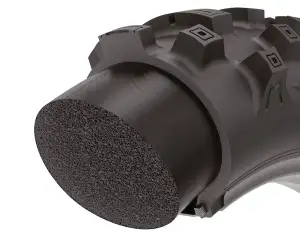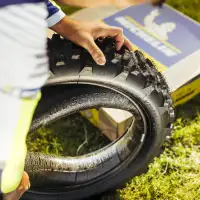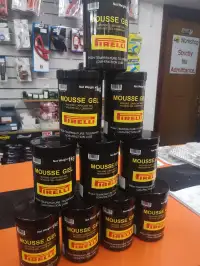What are Mousses in Enduro and Motocross Riding?


In the world of enduro and motocross, riders are constantly looking for equipment that delivers reliability, control, and performance for what are usually unpredictable off-road conditions.
One innovation that helps to battle harden your bike is the "mousse", a tyre insert that has become increasingly popular among off-road riders. If you're new to the sport, here's a beginner-friendly guide on what mousses are, why they’re used, and whether they’re right for you.
A mousse is a ring-shaped foam insert that replaces the traditional inner tube inside a dirt bike tyre. Originally developed by Michelin, the mousse (sometimes called a “bib mousse”) is made from a dense but flexible foam compound that replicates the effect of running your tyre at a particular pressure - typically around 13 psi, but various options are available.
Once installed, the mousse eliminates the need for air pressure, meaning the tyre can never go flat. It’s sealed entirely within the tyre and rim and is most commonly used in extreme enduro, motocross, and rally riding.

The main appeal of a mousse is puncture resistance. In off-road racing, riders will encounter rocks, roots and other sharp objects that can easily puncture a regular inner tube. With a mousse, flats are virtually impossible, allowing the rider to push harder and focus on performance, not tyre failure.
Additional benefits include:

Fitting a mousse isn't as straight forward as using an inner tube and will require a bit of practice!
Despite the benefits, mousses aren't perfect and there are some of the trade-offs:

In most countries, mousses are not road legal. They lack the required certification standards (such as DOT or ECE) because they are not air-filled, and their performance on tarmac at high speed is unpredictable. Heat build-up on paved roads can also cause them to deteriorate quickly, so you really wouldn’t want to be riding mousses anywhere other than the track.
If you ride in events that include road links (as in rally or long-distance enduro), check on the local regulations and use caution - you may choose to switch setups between sections to get the best performance.
Yes, but usually in a good way. With a mousse installed, you can confidently take on rougher lines, knowing you won’t get a flat. However, because mousses feel “softer” than inflated tyres, cornering can initially feel vague until you adjust. Riders may need to adapt by:
Checking the condition of a mousse isn't as straightforward as checking an air-filled inner tube, but with some experience and awareness of what to look out for, it becomes more manageable.
Even without opening up the tyre, you can spot some tell-take signs a mousse is becoming worn.

As a general rule race riders check them every few rides or definitely before an event. Casual riders can get away with checking them every few months, but in hard riding or in hot conditions, more regular checks are recommended.
If you notice changes in feel or handling, it’s worth opening up the tyre sooner.
Always re-lube your mousse during inspections. Dry foam wears out quicker and affects performance.

Get some lube on!
Mousses are a game-changer for serious enduro and motocross riders looking to eliminate puncture concerns and ride harder in rough terrain. They perform especially well in competitive environments or remote adventures where changing a tube isn’t feasible or simply becomes a major ball ache.
However, there are some caveats that beginners should fully understand before committing, so drop in to have a chat with us at Triple D Motosport for advice based on your riding style and steed.
For most off-road enthusiasts, mousses offer an unmatched level of security - just don’t expect to cruise to the pub with them legally, or comfortably.
